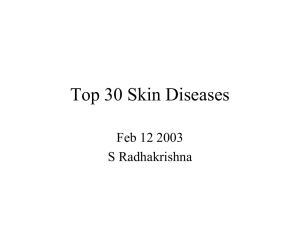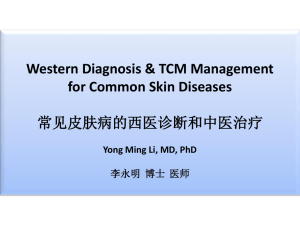Integumentary Diseases, Disorders, and Conditions Part I PPT
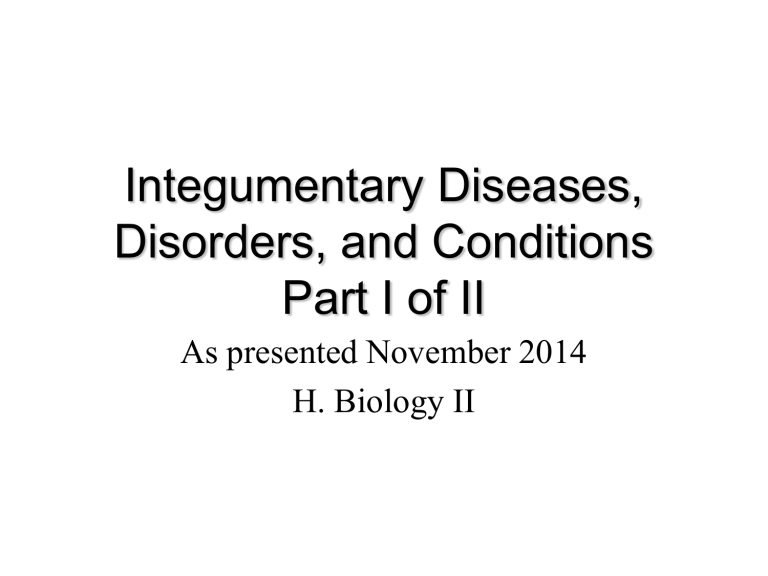
Integumentary Diseases,
Disorders, and Conditions
Part I of II
As presented November 2014
H. Biology II
Definitions
• Diseasean abnormal condition of the body or the mind that causes dysfunction or discomfort.
• Disordera functional abnormality, or disturbance.
• Conditiona state of being, in health, a disease, such as a heart condition.
Top Skin Diseases
• Scaly Red Rashes (5)
• Pigment Changes (2)
• Nodules (2)
• Purpura (1)
• Blisters (4)
• Systemic (3)
• Benign Growths (3)
• Premalignant
Growths (2)
• Malignant Growths
(3)
Scaly Red Rash 1: Seborrhea
Greasy yellow scaly plaques are characteristically distributed in the scalp,
Tzone of face, hairy areas of face
(eyebrows, eyelashes, beard), behind the ears, on the forehead, trunk, body folds, and genitalia .Unknown etiology.
"cradle cap" focal parakeratosis, moderate acanthosis, slight spongiosis and a mild, mixed inflammatory infiltrate.
Red or pink papule/plaque with silvery or micaceous scaling. The fingernails may show dystrophy, depressions known as "pits" and subungual debis
Scaly Red Rash 2: Psoriasis presence of a thickened epidermis and stratum corneum containing neutrophils and neutophilic debris ; no granular layer, elongation of the rete ridges; T cell involvement in etiology
Psoriasis
• It can appear anywhere on the body, but it is most commonly found on the elbows , knees , scalp , and lower back .
• Skin typically becomes red and inflamed and may form white scaly patches .
• It can be quite painful and may itch , crack , and bleed .
• While psoriasis may look like just a skin disease, it is in fact a disease of the immune system.
Centrifugally spreading, reddish or pink plaques or patches with slightly raised advancing edge. Annular. Itchy rash caused by fungus Tricophytum rubrum in most cases.
Tinea corporis Tinea corporis
Scaly Red Rash 3: Tinea
Tinea versicolor
Tinea unguium
Tinea versicolor
Parakeratosis
Tinea capitis thick stratum corneum
Tinea capitis KOH prep on hair
“spaghetti and meatballs”
PAS stain showing fungi
Tinea pedis
Tinea Pedis-
Athletes’ Foot
• Athlete's foot is a very common skin infection of the foot caused by fungus.
• . When the feet or other areas of the body stay moist, warm, and irritated , this fungus can thrive and infect the upper layer of the skin..
• Athlete's foot is caused by the ringworm fungus
("tinea" in medical jargon). Athlete's foot is also called tinea pedis. The fungus that causes athlete's foot can be found on many locations, including floors in gyms, locker rooms, swimming pools, nail salons, and in socks and clothing.
• The fungus can also be spread directly from person to person or by contact with these objects.
Scaly Red Rash 4: Eczema
Eczema is very itchy. There are variants of eczema, the so-called "messy" rash, for example, "irritant" eczema, atopic eczema, and contact eczema, all of which are characterized by rashes that are quite itchy and appear "messy" because they are often scratched.TH2 mediated DTH
Flexural distribution
Lichenification from scratching crusting in the stratum corneum (making one think of a "messy rash") and the "spongiosis" or epidermal edema, as evidenced by the relative pallor around the keratinocytes.
Eczema
• Eczema most commonly causes dry, reddened skin that itches or burns, although the appearance of eczema varies from person to person and varies according to the specific type of eczema.
• Intense itching is generally the first symptom in most people with eczema.
• Sometimes, eczema may lead to blisters and oozing lesions , but eczema can also result in dry and scaly skin .
• Repeated scratching may lead to thickened , crusty skin.
Scaly Red Rash 5: Scabies
Scabies (or infestation with the
Sarcopetes mite), especially when untreated, can lead to a widespread eczema rash with a few additional distintive features such as heavy involvement in the groin or skin folds and, in particular, involvement of the interdigital web spaces with crusting.
one finds a lot going on in the stratum corneum. Here one can see traces of the mite.
With Fontana Masson stain, lesions of long standing vitiligo (right hand panel) show no melanocytes. In normal skin (left panel) darkly stain melanocytes are visible along the dermoepidermal junction.
Pigment Changes 1: Vitiligo
Vitiligo
• Vitiligo (vit-ill-EYE-go) is a pigmentation disorder in which melanocytes (the cells that make pigment) in the skin are destroyed. As a result, white patches appear on the skin in different parts of the body.
• Similar patches also appear on both the mucous membranes (tissues that line the inside of the mouth and nose), and the retina
(inner layer of the eyeball).
• The hair that grows on areas affected by vitiligo sometimes turns white.
Pigment Changes 2: Melasma large amount of melanin in the basal layer
HPV mediated. Here shown is common wart
Papules/Plaques 1: Warts
Flat wart
Genital wart
Aka condyloma acuminatum
Plantar wart
The hallmarks of warts are hyperkeratosis, papillomatosis
(outward expansion of the spinous layer) and acanthosis.
The epidermis contains foci of vacuolated cells (koilocytes), clumped keratohyaline granules, and vertical tiers of parakeratotic cells (stratum corneum with retained nuclei).
Warts
• Common warts are local growths in the skin that are caused by human papillomavirus
(HPV) infection.
• Although they are considered to be contagious , it is very common for just one family member to have them.
• They often affect just one part of the body
(such as the hands or the feet) without spreading over time to other areas.
Papules/Plaques 2: Molluscum dome-shaped pink-brown papules with secondary umbilication noted in mnay of the well-developed lesions ballooning-like changes in the keratinocytes as they approach the granular layer. There are intracellular inclusion bodies known as molluscum bodies.
Papules/Plaques 3: Acne Vulgaris
Acne Vulgaris
• Acne vulgaris is a common skin disease that affects 85-100% of people at some time during their lives.
• It is characterized by non-inflammatory pustules or comedones , and by inflammatory pustules, and nodules in its more severe forms.
• Acne vulgaris affects the areas of skin with the densest population of sebaceous follicles ; these areas include the face, the upper part of the chest, and the back.
• Treatment is a regimine of topical creams, and oral antibiotics, and or steroids.
Papules/Plaques 4: Urticaria (Hives)
There is little that appears wrong in this histology except for the fact that there is a separation of the collagen bundles, more so than one would usually see in normal skin. There is also a sparse infiltrate in which an occasional lymphocyte may be seen
Urticaria
• Hives (medically known as urticaria ) are red, itchy, raised areas of skin that appear in varying shapes and sizes.
• They range in size from a few millimeters to several inches in diameter.
• Hives can be round , or they can form rings or large patches.
• Wheals (welts), red lesions with a red "flare" at the borders , are another manifestation of hives.
• Hives can occur anywhere on the body, such as the trunk, arms, and legs.
Papules/Plaques 5: Erythema
Multiforme
The pathologic features of erythema multiforme include a perivascular, lymphocytic infiltrate of variable intensity, vacuolization of the dermalepidermal junction, extravasation of red blood cells without vasculitis, papillary dermal edema, and variable eosinophilic necrosis of the epidermis.
Nodules 1: Erythema Nodosum histologic findings associated with erythema nodosum are largely localized to the deep dermis and the subcutaneous tissue. There is an accumulaton of lymphocytes, neutrophils, histiocytes, and giant cells accumulate in the fibrous septae between fat lobules and perivascular infiltration of lymphocytes in the dermis.
Nodules 2: Keloids change in the diameter of the collagen bundles and a kind of bluish background, the latter indicating that there is some mucin there.
Keloid
• A keloid is a scar that doesn't know when to stop . When the cells keep on reproducing, the result is an overgrown (hypertrophic) scar or a keloid .
• A keloid looks shiny and is often domeshaped, ranging in color from slightly pink to red.
• It feels hard and thick and is always raised above the surrounding skin.
vasculitis of the superficial vascular plexus.
One sees extravation of red blood cells, indicating that the vessels must have been damaged. There is a lot of neutrophilic debris.
Purpura 1: Vasculitis larger vessel is involved in an inflammatory porcess
Blisters 1: Herpes
Note: these images are kind of weak, also, not sure if they are only referring to HSV 1 or HSV 1 and HSV 2.
cells in the epidermis are undergoing degenerative changes. There is acantholysis (epidermal cells falling apart) and enlarging of the nuclei. In some specimens, one might be lucky enough to see the diagnostic mltinucleated giant cells
sub-epidermal blister and an infiltrate with plenty of eosinophils
Blisters 2: Bullous Pemphigoid
Blisters 3: Pemphigus Vulgaris
Mucosal involvement
INTRAEPIDERMAL split! (above basal layer)
Blisters 4: Acute Contact Dermatitis
Contact Dermatitis
• The word "dermatitis" means inflammation of the skin .
• In contact dermatitis, the skin becomes extremely itchy and inflamed , causing redness, swelling, cracking, weeping, crusting, and scaling.
• Dry skin is a very common complaint and an underlying cause of some of the typical rash symptoms.
• This is usually occupationally related : hair stylists, medical personnel, photographers, etc.
Systemic 1: Lupus discoid lupus. There is a perivascular and periappendageal lymphocytic infiltrate that also tends to hug the dermo-epidermal junction, the latter type of infiltrate being referred to as "lichenoid
The collagen bundles are thickened and homogenized.
Systemic 2: Scleroderma
Systemic 3: Drug Eruption
LentiginesThese brown macules are sometimes inappropriately referred to as "liver spots" by lay people.
Benign Growths 1: Lentigo two features here: the excess pigment in the basal layer and the peculiar elongation of the epidermis itself, sometimes likened to a
"hockey stick".
Benign Growths 2: Seborrheic
Keratosis epidermal growth whose borders can almost be distinguished by a pencil line drawing. The cells are banal and basophilic. There are often
"pseudo-horn cysts" or keratinaceous intra-epidermal inclusions.
